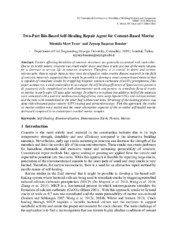Two-part bio-based self-healing repair agent for cement-based mortar
| dc.contributor.author | Tezer, Mustafa Mert | |
| dc.contributor.author | Bundur, Zeynep Başaran | |
| dc.date.accessioned | 2024-03-01T11:04:47Z | |
| dc.date.available | 2024-03-01T11:04:47Z | |
| dc.date.issued | 2020 | |
| dc.identifier.uri | http://hdl.handle.net/10679/9253 | |
| dc.identifier.uri | https://www.scipedia.com/public/Tezer_Bundur_2020a | |
| dc.description.abstract | Factors affecting durability of concrete structures are generally associated with each other. Due to its brittle nature, concrete can crack under stress and these cracks are one of the main reasons for a decrease in service life in concrete structures. Therefore, it is crucial to detect and recover microcracks, then to repair them as they were developed to wider cracks. Recent research in the field of concrete materials suggested that it might be possible to develop a smart cement-based material that is capable of remediate cracks by triggering biogenic calcium carbonate (CaCO3) precipitaton. This paper summarizes a study undertaken to investigate the self-healing efficiency of Sporosarcina pasteurii (S. pasteurii) cells immobilized on both diatomaceous earth and pumice, to remediate flexural cracks on mortar in early ages (28 days after mixing). To obtain a two-phase bio additive, half of the minerals were saturated with a nutrient medium consisting of urea, corn-steep liqueur(CSL) and calcium acetate and the cells with immobilized to the other half without nutrients. Screening of the healing process was done with ultrasonic pulse velocity (UPV) testing and stereomicroscopy. With this approach, the cracks on mortar surface were sealed and the water absorption capacity of the so-called self-healed mortar decreased compared to its counterpart cracked mortar samples. | en_US |
| dc.description.sponsorship | TÜBİTAK | |
| dc.language.iso | eng | en_US |
| dc.publisher | International Center for Numerical Methods in Engineering | en_US |
| dc.relation | info:turkey/grantAgreement/TUBITAK/118M327 | |
| dc.relation.ispartof | Current Topics and Trends on Durability of Building Materials and Components - Proceedings of the 15th International Conference on Durability of Building Materials and Components, DBMC 2020 | |
| dc.rights | openAccess | |
| dc.rights | Attribution-NonCommercial-ShareAlike 3.0 Unported | |
| dc.rights.uri | https://creativecommons.org/licenses/by-nc-sa/3.0/deed.en | |
| dc.title | Two-part bio-based self-healing repair agent for cement-based mortar | en_US |
| dc.type | Conference paper | en_US |
| dc.publicationstatus | Published | en_US |
| dc.contributor.department | Özyeğin University | |
| dc.contributor.authorID | (ORCID 0000-0003-1398-4021 & YÖK ID 205281) Başaran, Zeynep | |
| dc.contributor.ozuauthor | Bundur, Zeynep Başaran | |
| dc.identifier.startpage | 137 | en_US |
| dc.identifier.endpage | 144 | en_US |
| dc.identifier.doi | 10.23967/dbmc.2020.142 | en_US |
| dc.subject.keywords | Biomineralization | en_US |
| dc.subject.keywords | Diatomaceous earth | en_US |
| dc.subject.keywords | Mortar | en_US |
| dc.subject.keywords | Pumice | en_US |
| dc.subject.keywords | Self-Healing | en_US |
| dc.identifier.scopus | SCOPUS:2-s2.0-85122008060 | |
| dc.contributor.ozugradstudent | Tezer, Mustafa Mert | |
| dc.relation.publicationcategory | Conference Paper - International - Institutional Academic Staff and Graduate Student |
Files in this item
This item appears in the following Collection(s)
Share this page




